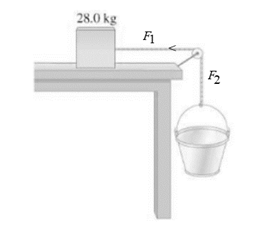
Concept explainers
(a)
The mass of the sand added to bucket.
(a)
Answer to Problem 76GP
The mass of sand added to bucket is
Explanation of Solution
Given:
The mass of the block is,
The mass of the empty bucket is,
The coefficient of static friction between table and block is,
The coefficient of kinetic friction between table and block is,
Formula Used:
Draw the free body diagram of the system.

Here, the force on the rope toward the block is
The expression to calculate the mass of sand added to bucket is,
Where,
Calculation:
Substitute all the values in the above expression.
Conclusion:
Thus, the mass of sand added to bucket is
(b)
The acceleration of the system.
(b)
Answer to Problem 76GP
The acceleration of the system is
Explanation of Solution
Given:
The mass of the block is,
The mass of the empty bucket is,
The coefficient of static friction between table and block is,
The coefficient of kinetic friction between table and block is,
Formula Used:
The expression to calculate the acceleration of the system is,
Where,
Calculation:
Substitute all the values in the above expression.
Conclusion:
Thus, the acceleration of the system is
Chapter 4 Solutions
Physics: Principles with Applications
Additional Science Textbook Solutions
University Physics with Modern Physics (14th Edition)
College Physics: A Strategic Approach (4th Edition)
College Physics
Cosmic Perspective Fundamentals
Physics for Scientists and Engineers: A Strategic Approach, Vol. 1 (Chs 1-21) (4th Edition)
 College PhysicsPhysicsISBN:9781305952300Author:Raymond A. Serway, Chris VuillePublisher:Cengage Learning
College PhysicsPhysicsISBN:9781305952300Author:Raymond A. Serway, Chris VuillePublisher:Cengage Learning University Physics (14th Edition)PhysicsISBN:9780133969290Author:Hugh D. Young, Roger A. FreedmanPublisher:PEARSON
University Physics (14th Edition)PhysicsISBN:9780133969290Author:Hugh D. Young, Roger A. FreedmanPublisher:PEARSON Introduction To Quantum MechanicsPhysicsISBN:9781107189638Author:Griffiths, David J., Schroeter, Darrell F.Publisher:Cambridge University Press
Introduction To Quantum MechanicsPhysicsISBN:9781107189638Author:Griffiths, David J., Schroeter, Darrell F.Publisher:Cambridge University Press Physics for Scientists and EngineersPhysicsISBN:9781337553278Author:Raymond A. Serway, John W. JewettPublisher:Cengage Learning
Physics for Scientists and EngineersPhysicsISBN:9781337553278Author:Raymond A. Serway, John W. JewettPublisher:Cengage Learning Lecture- Tutorials for Introductory AstronomyPhysicsISBN:9780321820464Author:Edward E. Prather, Tim P. Slater, Jeff P. Adams, Gina BrissendenPublisher:Addison-Wesley
Lecture- Tutorials for Introductory AstronomyPhysicsISBN:9780321820464Author:Edward E. Prather, Tim P. Slater, Jeff P. Adams, Gina BrissendenPublisher:Addison-Wesley College Physics: A Strategic Approach (4th Editio...PhysicsISBN:9780134609034Author:Randall D. Knight (Professor Emeritus), Brian Jones, Stuart FieldPublisher:PEARSON
College Physics: A Strategic Approach (4th Editio...PhysicsISBN:9780134609034Author:Randall D. Knight (Professor Emeritus), Brian Jones, Stuart FieldPublisher:PEARSON





